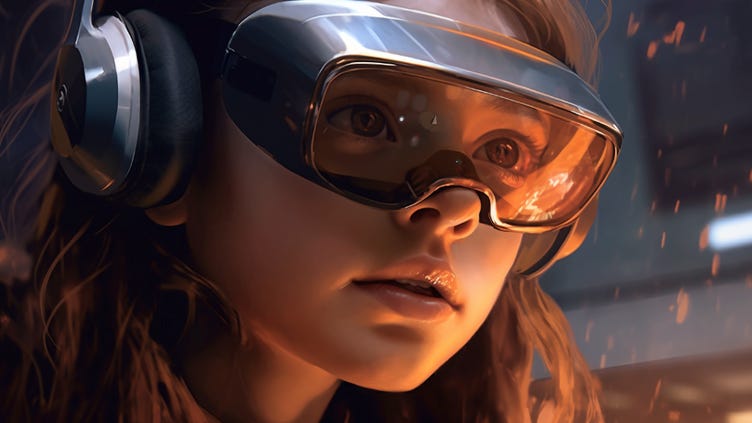Emotion Tracking in XR (S01/E20)
By understanding a user's emotional state, XR applications can adapt in real-time, offering a more tailored and responsive experience.
Extended Reality (XR), an umbrella term encompassing Virtual Reality (VR), Augmented Reality (AR), and Mixed Reality (MR), has been at the forefront of technological advancements in recent years. As the technology matures, there's a growing interest in making XR experiences more immersive and personalized. One way to achieve this is through emotion tracking. By understanding a user's emotional state, XR applications can adapt in real-time, offering a more tailored and responsive experience.
1. Facial Expression Recognition
How it works: Cameras, often infrared, are mounted on the VR headset or external devices to capture facial movements. Advanced algorithms then analyze these movements to recognize specific facial expressions associated with emotions.
Advancements:
Depth-sensing cameras: These cameras can capture 3D facial structures, allowing for more accurate emotion detection.
Machine Learning: With the integration of machine learning, the accuracy of facial expression recognition has improved significantly. The more data these algorithms process, the better they become at predicting emotions.
Applications: Beyond emotion tracking, facial recognition in XR can be used for identity verification, avatar customization, and more interactive gaming experiences.
2. Eye Tracking
How it works: Infrared sensors track the movement and position of the pupil. By analyzing where a user is looking and how their eyes move, the system can infer certain emotional states.
Advancements:
Foveated Rendering: This technique, combined with eye tracking, adjusts the resolution of the image based on where the user is looking, providing a more efficient and immersive experience.
Pupil Dilation Analysis: The dilation and constriction of the pupil can be indicators of emotional arousal. Advanced eye-tracking systems can measure these subtle changes to infer emotions.
Applications: Eye tracking can enhance user experience by providing more intuitive controls, improving user interface design, and offering insights into user engagement.
3. Heart Rate Monitors
How it works: Photoplethysmography (PPG) sensors, often found in VR controllers or wearable devices, use light to measure the blood volume changes in microvascular tissue, which allows them to determine heart rate.
Advancements:
Heart Rate Variability (HRV): By analyzing the time intervals between heartbeats, HRV can provide insights into emotional states and stress levels.
Integration with Haptic Feedback: Some VR systems integrate heart rate data with haptic feedback, allowing users to "feel" their heartbeat, enhancing immersion.
Applications: Beyond emotion tracking, heart rate data can be used in fitness applications, meditation guides, and biofeedback therapy in XR environment.
4. Galvanic Skin Response (GSR)
How it works: Electrodes measure the electrical conductance of the skin. As emotional arousal increases, sweat gland activity also increases, leading to higher skin conductance.
Advancements:
Wearable Tech: Modern GSR sensors are becoming more compact and can be integrated into wearable devices like wristbands or gloves.
Real-time Feedback: Advanced systems can provide real-time feedback based on GSR data, allowing XR applications to adapt instantly to the user's emotional state.
Applications: GSR is widely used in lie detector tests, but in the context of XR, it can be used in therapeutic applications, gaming, and user experience research.
In the near Future:
1. Brain-Computer Interfaces (BCIs): BCIs can read and interpret neural activity. In the future, we might see non-invasive BCIs that can determine emotions directly from brainwaves, offering a more accurate and comprehensive understanding of a user's emotional state.
2. Thermal Cameras: Changes in facial temperature can correlate with certain emotions. For instance, blushing (a rise in facial temperature) can indicate embarrassment. Future XR devices might incorporate thermal cameras to detect such changes.
3. Voice Analysis: By analyzing pitch, tone, and speed of a user's voice, it's possible to infer emotions. Future XR applications might use voice recognition not just for commands but also for emotion detection.
Impact of Tracked Emotions in Virtual Worlds
1. Personalized Content: Imagine a VR game that adapts its storyline based on your emotions. If you're feeling scared, the game might reduce the intensity of jump scares. Conversely, if you're bored, it might introduce more challenging elements.
2. Enhanced Social Interactions: In virtual social spaces, emotion tracking can allow for more expressive avatars. Your virtual representation could reflect your real-world emotional state, leading to more genuine interactions.
3. Mental Health Applications: Emotion tracking in XR can be a powerful tool for therapeutic applications. For instance, exposure therapy in VR could be adjusted in real-time based on a patient's anxiety levels.
4. Training and Education: In educational XR applications, understanding a student's emotional state can be crucial. If a student is frustrated or confused, the application can provide additional resources or explanations.
5. Ethical Considerations: While emotion tracking offers many benefits, it also raises privacy concerns. Users need to be aware of when and how their emotions are being tracked, and they should have control over this data.
XR Glossary
Alignment Initialization (S01/E13)
AR Anchor Techniques (S01/E02)
AR Cloud explained (S01/03)
AR markers (S01/E05)
AR Collaboration (S01/E08)
Assisted Reality (S01/14)
Brain-Computer Interface (S01/E21)
CAVE (S01/E18)
Emotion Tracking (S01/E20)
FoV (S01/E15)
Geospatial Augmented Reality (S01/E11)
Haptic feedback (S01/09)
Head-Mounted Displays (HMDs) (S01/E17)
Light Field Display (S01/E10)
Markerles AR (S01/E07)
Occlusion (S01/06)
Pass-through technology (S01/E12)
SLAM - Simultaneous Localization and Mapping (SLAM) (S01/E01)
Spatial Body Language (S01/E19)
Skeleton View (S01/E16)
Web AR technology (S01/E04)

